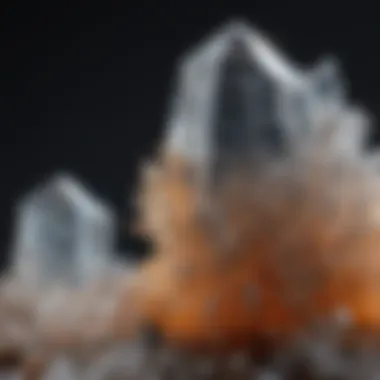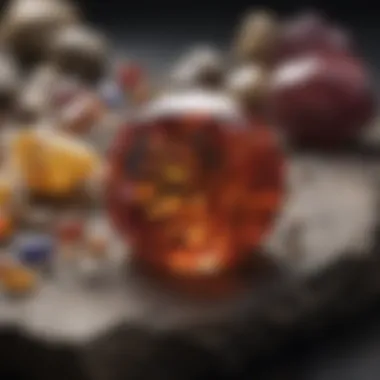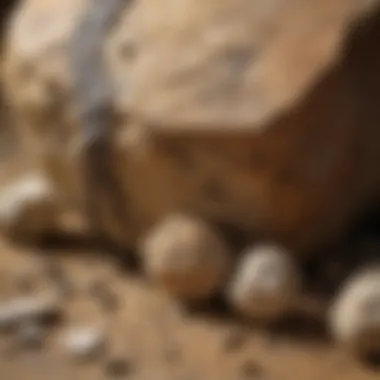Unveiling the Significance of Mohs Scale in Geology and Collecting


Rock and Fossil Identification
In the realm of geology and collecting, understanding the Mohs scale is paramount for enthusiasts. The Mohs scale serves as a fundamental tool in evaluating the hardness of minerals and gemstones. By grasping the significance of this scale, rock and fossil collectors can ascertain the durability of their geological specimens, enhancing their appreciation for each piece in their collection.
Geological Insights
Delving deeper into the Mohs scale reveals the intricate relationship between mineral hardness and geological processes. By examining the historical context of rocks and fossils, one can uncover not only their compositional diversity but also their role in shaping our understanding of the Earth's past. Additionally, notable discoveries in the field shed light on groundbreaking findings that have contributed to the advancement of geological knowledge.
Preservation and Display
Preserving rocks and fossils requires meticulous care and attention to detail. Utilizing specific techniques, collectors can maintain the integrity of their specimens for future generations. Proper storage methods are crucial in preventing degradation, while creative display ideas offer a visually appealing showcase for geological treasures. Incorporating these preservation and display practices ensures that rocks and fossils remain well-preserved and presented in an engaging manner.
Collecting Tips and Techniques
For avid collectors, exploring prime collecting sites is essential for acquiring unique specimens. By adhering to best practices and employing appropriate tools, enthusiasts can safely extract geological treasures without causing harm to the environment or the specimens themselves. Understanding the characteristics to look for in rocks and fossils enables collectors to identify and differentiate various types, enriching their collection with diverse and fascinating specimens.
Introduction to Mohs Scale
In this section, we delve into the foundational aspects of the Mohs Scale, a crucial tool in the realms of geology and collecting. Understanding the Mohs Scale is paramount for enthusiasts interested in assessing the hardness of minerals and gemstones within their collections. The scale provides a standardized method for evaluating the relative hardness of various materials, offering a fundamental framework for comparison and analysis. By exploring the history and significance of the Mohs Scale, we can gain a deeper appreciation for the durability and resilience of geological specimens. This section serves as the gateway to unlocking the complexities of mineral hardness and its implications for both scientific and aesthetic pursuits.
Defining Mohs Scale
Creation of the Mohs Scale
The creation of the Mohs Scale stemmed from the innovative work of Friedrich Mohs in the early 19th century. Mohs, a German mineralogist, introduced this scale as a means of classifying minerals based on their scratch resistance. This unique system revolutionized the field of geology by providing a simple yet effective method for determining the relative hardness of different minerals. One of the key characteristics of the Mohs Scale is its use of a comparative scale from 1 to 10, with each number corresponding to a specific mineral's hardness. This approach allows for quick and practical mineral identification, making it a popular choice for geologists and collectors alike. Despite its simplicity, the Mohs Scale offers invaluable benefits in categorizing mineral hardness, although its reliance on scratch testing may have limitations in certain scenarios.
Principles of Mohs Scale
The principles underlying the Mohs Scale are rooted in the concept of hardness relative to scratch resistance. This fundamental property of minerals guides their placement on the scale, with talc representing the softest mineral at level 1 and diamond epitomizing the hardest at level 10. The key characteristic of the Mohs Scale lies in its qualitative approach to hardness assessment, focusing on the ability of one mineral to scratch another. This characteristic makes the Mohs Scale a beneficial choice for this article as it offers a clear and systematic way to rank minerals according to their hardness levels. However, while the Mohs Scale simplifies hardness classification, its main disadvantage lies in the subjectivity of scratch testing, which may lead to variations in results.


Significance in Geology
In the geological context, the Mohs Scale plays a pivotal role in mineral identification, aiding geologists in distinguishing between different minerals based on their hardness levels. This practical tool allows for quick assessments of a mineral's scratch resistance, facilitating efficient classification and study. By utilizing the Mohs Scale in mineral identification, geologists can streamline their research processes and enhance the accuracy of their findings. Moreover, the Mohs Scale's application extends to geological testing, where it serves as a critical instrument in examining the physical properties of rocks and minerals. Through the systematic use of the Mohs Scale, geologists can determine the relative hardness of various specimens, contributing to a more comprehensive understanding of geological formations.
Application in Mineral Identification
The application of the Mohs Scale in mineral identification offers geologists a reliable method for categorizing minerals based on their scratch resistance. By comparing the ability of a mineral to scratch another, geologists can determine its position on the Mohs Scale, providing valuable insights into its hardness. This key characteristic of the Mohs Scale simplifies the process of mineral identification, making it a popular choice for geologists seeking efficient and practical solutions. However, while the Mohs Scale enhances the accuracy of mineral classification, its reliance on scratch testing may pose limitations in cases where other factors influence hardness determinations.
Role in Geological Testing
In the realm of geological testing, the Mohs Scale serves as an indispensable tool for assessing the physical properties of rocks and minerals. Geologists leverage the scale's standardized hardness values to conduct thorough examinations of geological specimens, aiding in the characterization and analysis of different materials. The key characteristic of the Mohs Scale, which assigns numerical values to mineral hardness, offers geologists a systematic approach to evaluating the hardness of specimens during geological testing. This feature makes the Mohs Scale a beneficial choice for this article as it highlights the significance of hardness assessments in geological research. Nevertheless, while the Mohs Scale provides valuable data for geological testing, its reliance on scratch testing may not always align with the complexities of geological processes.
Relevance in Collecting
For collectors of gemstones and geological specimens, the Mohs Scale holds immense relevance in evaluating the hardness of their prized possessions. By understanding the hardness levels of gemstones, collectors can make informed decisions regarding preservation and display practices. Moreover, the Mohs Scale aids collectors in safeguarding their specimens from potential damage, ensuring the longevity of their collections. This section delves into the practical applications of the Mohs Scale in collecting contexts, shedding light on its importance for enthusiasts seeking to enhance their appreciation of mineralogical treasures.
Evaluating Gemstone Hardness
When evaluating gemstone hardness, collectors rely on the Mohs Scale as a benchmark for assessing the durability of different gem varieties. By referencing the hardness levels assigned to specific gemstones on the Mohs Scale, collectors can determine the best practices for handling, storing, and displaying their treasures. The key characteristic of using the Mohs Scale for gemstone evaluation lies in its standardized approach to hardness assessment, providing collectors with a common language for discussing and categorizing gems. This unique feature of the Mohs Scale offers advantages to collectors by enabling them to make informed decisions about their gemstone collections; however, it is important to note that the scale's focus on scratch resistance may not encompass all aspects of gemstone durability.
Protecting Geological Specimens
Protecting geological specimens from damage is a primary concern for collectors, and the Mohs Scale plays a crucial role in guiding preservation efforts. By understanding the relative hardness of geological specimens, collectors can implement suitable storage and display techniques to prevent scratching and deterioration. The key characteristic of utilizing the Mohs Scale for protecting geological specimens lies in its ability to prioritize preservation practices based on hardness levels. This beneficial feature of the Mohs Scale equips collectors with the knowledge needed to care for their specimens effectively. However, while the Mohs Scale offers guidance on protecting geological specimens, collectors must also consider supplementary factors such as environmental conditions and handling procedures to ensure comprehensive preservation.
This comprehensive guide aims to illuminate the multifaceted nature of the Mohs Scale in geology and collecting, providing enthusiasts with a deeper understanding of mineral hardness and its implications in their respective fields.
Understanding Hardness Levels
The section on Understanding Hardness Levels delves deep into the intricacies of assessing the hardness of minerals and gemstones. It plays a crucial role in the realm of geology and collecting by providing a framework for evaluating the durability of geological specimens. The significance of Understanding Hardness Levels lies in its ability to determine the relative hardness of various minerals, aiding enthusiasts in identifying and appreciating the toughness of different geological materials. By understanding the diverse hardness levels present in minerals and gemstones, collectors are equipped with valuable knowledge to assess the durability and quality of their specimens thoroughly. This section highlights the importance of comprehending hardness levels in geology and collecting, offering insights into the intricate world of mineral durability and gemstone hardness.


Comparative Analysis
Assessing Different Minerals
Assessing Different Minerals plays a vital role in the overall understanding of hardness levels. This component focuses on evaluating the diverse hardness levels exhibited by various minerals, providing collectors with essential information to differentiate between softer and harder geological materials. By discussing the distinct characteristics of different minerals in terms of hardness, collectors can make informed decisions regarding the handling and preservation of their specimens. Assessing Different Minerals serves as a valuable tool for enthusiasts to compare and contrast the durability of different minerals, enabling them to prioritize the protection of more fragile specimens. Despite its complexity, assessing different minerals offers a comprehensive view of the hardness spectrum present in geological specimens, contributing significantly to the thorough appreciation of mineral hardness in collections.
Implications for Fossil Preservation
Delving into the Implications for Fossil Preservation enriches the understanding of how hardness levels impact the long-term conservation of fossils. This facet focuses on the implications of mineral hardness concerning the preservation of fossils, shedding light on the challenges and considerations involved in maintaining the integrity of fossilized remains. By exploring the significance of hardness in fossil preservation, collectors gain valuable insights into the best practices for safeguarding delicate artifacts from geological history. Understanding how hardness levels affect fossil integrity is essential for collectors to implement adequate preservation techniques and ensure the longevity of their fossil collections. Despite the nuances involved, grasping the implications for fossil preservation offers collectors a holistic view of the interplay between hardness levels and the conservation of ancient remains.
Practical Applications
Utilization in Jewelry Making
The utilization of the Mohs scale in Jewelry Making underscores its practical application in the creation of exquisite jewelry pieces. This aspect emphasizes how hardness levels influence the selection of gemstones for jewelry, emphasizing durability and longevity in jewelry design. By considering the hardness of gemstones based on the Mohs scale, jewelry makers can create stunning pieces that withstand the test of time and daily wear. The utilization of the Mohs scale in Jewelry Making presents a systematic approach to choosing gemstones, ensuring that the jewelry remains intact and retains its beauty for years to come. Despite the intricacies involved in selecting gemstones based on hardness, the utilization of the Mohs scale offers jewelry makers a reliable framework for crafting resilient and aesthetically pleasing pieces.
Importance in Lapidary Arts
The importance of the Mohs scale in Lapidary Arts delves into its role in shaping the creation of intricate lapidary works. This aspect highlights how hardness levels dictate the selection and shaping of gemstones in lapidary art, emphasizing the precision and skill required in working with different mineral hardness. By recognizing the importance of the Mohs scale in Lapidary Arts, craftsmen can execute meticulous cuts and designs that showcase the beauty and durability of gemstones. The Mohs scale guides lapidary artists in choosing the right materials for their creations, ensuring that each piece reflects an exceptional level of craftsmanship and durability. Despite the challenges posed by varying hardness levels, the importance of the Mohs scale in Lapidary Arts offers artisans a structured approach to working with diverse gemstones, resulting in exquisite and enduring lapidary pieces.
Mohs Scale in Practice
In this section, we delve deep into the practical application of the Mohs Scale within the context of geology and collecting. Understanding the nuances of the Mohs Scale in practice is crucial for enthusiasts looking to evaluate the hardness of various minerals and gemstones accurately. By embracing the Mohs Scale in practice, individuals gain a comprehensive insight into the durability and resilience of geological specimens in their collections.
Testing Procedures
Conducting Hardness Tests
When it comes to conducting hardness tests, precision and accuracy are paramount. By meticulously following standardized procedures, enthusiasts can determine the relative hardness of different mineral specimens, aiding in their identification and classification. The process of conducting hardness tests involves carefully selecting the appropriate testing tools and methodologies to ensure reliable results. Conducting hardness tests allows collectors to create a hierarchy of hardness levels among their specimens, facilitating better organization and understanding of their geological collection.


Interpreting Results
Interpreting the results of hardness tests is an intricate process that demands both expertise and attention to detail. By analyzing the data obtained from hardness tests, collectors can draw valuable insights into the properties of various minerals and gemstones. Understanding how to interpret results accurately enables enthusiasts to assess the structural integrity and wear resistance of geological specimens effectively. Interpreting results plays a pivotal role in determining the practical applications of different minerals, guiding collectors in their selection and preservation decisions.
Common Examples
Listing Gemstones by Hardness
Creating a comprehensive list of gemstones based on their hardness levels is a fundamental task for collectors and geologists alike. By categorizing gemstones according to the Mohs Scale, enthusiasts can better appreciate the diverse range of hardness exhibited by different specimens. Listing gemstones by hardness provides a comprehensive reference point for collectors, assisting them in identifying suitable materials for various applications such as jewelry making or artistic pursuits.
Illustrating with Real-Life Samples
Illustrating the principles of the Mohs Scale with real-life samples offers enthusiasts tangible examples to enhance their understanding of mineral hardness. By showcasing actual specimens with varying hardness levels, collectors can observe firsthand the distinguishing features that characterize different minerals. Illustrating with real-life samples brings the theoretical concepts of the Mohs Scale to life, enabling enthusiasts to develop a deeper appreciation for the geological diversity present in their collections.
Practical Implications for Collectors
In this section of our comprehensive exploration of the Mohs Scale in Geology and Collecting, we delve into the crucial area of Practical Implications for Collectors. Emphasizing the significance of this topic will provide valuable insight for enthusiasts in the field. Deciphering the optimal approaches and strategies when handling geological specimens is essential for collectors to maintain the integrity and longevity of their collections. By discussing specific elements such as preservation techniques and storage recommendations, this segment aims to equip collectors with the knowledge and tools necessary to enhance their collecting experience.
Preservation Techniques
Best Practices for Display
Unraveling the intricate nuances of Best Practices for Display is fundamental for collectors seeking to showcase their geological treasures effectively. Understanding the key characteristic of thoughtful display methods and why they contribute to the overall preservation of specimens is paramount. By illuminating the unique features that distinguish superior display practices, collectors can ascertain the advantages and potential drawbacks of various presentation options. Examining the role of presentation in highlighting the beauty and authenticity of geological specimens underscores its pivotal place in this article.
Preventing Damage
Delving into the realm of Preventing Damage illuminates the strategies and principles essential for safeguarding precious geological specimens. Highlighting the key characteristic of damage prevention measures and their significance in upholding specimen integrity brings to light the importance of this facet in the context of collectors. By detailing the distinctive features that set effective damage prevention apart, collectors can discern the merits and limitations of different protective techniques, enriching their understanding of safeguarding geological collections.
Storage Recommendations
In the following discussion on Storage Recommendations, we unveil essential insights into organizing and preserving geological samples. Exploring the nuances of Ideas for Proper Organization sheds light on the pivotal role efficient storage plays in maintaining collection integrity. By showcasing the key characteristic of organized storage solutions and their benefits in enhancing accessibility and longevity, collectors can appreciate the unique advantages offered by structured organization. Evaluating the unique features of proper storage methods and their impact on collection preservation provides collectors with a comprehensive outlook on maintaining valuable specimens.
Long-Term Preservation Tips
Delving into Long-Term Preservation Tips offers invaluable guidance on ensuring prolonged durability and beauty of geological specimens. Emphasizing the key characteristic of preventative measures and their role in mitigating long-term degradation underscores the importance of proactive preservation strategies for collectors. By elucidating the distinctive features that set effective long-term preservation practices apart, collectors can grasp the benefits and potential drawbacks of different preservation methodologies, empowering them to make informed decisions in safeguarding their geological collections.







